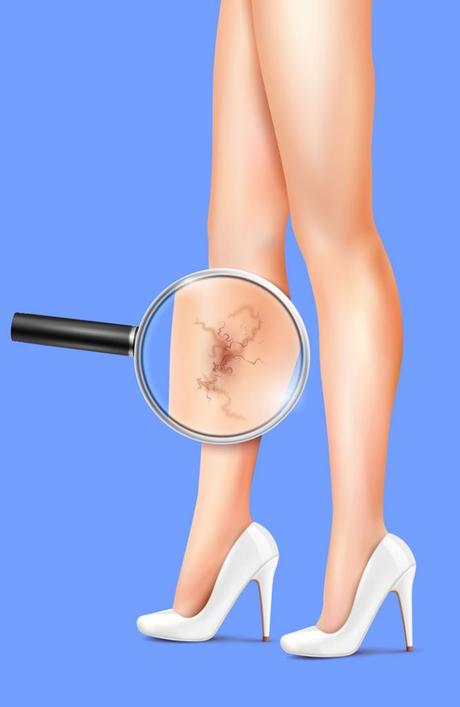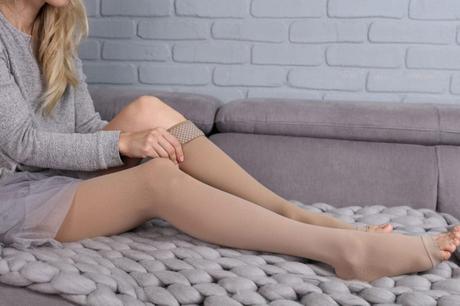A varicose vein is a swollen, twisted vein that is often easily visible under the skin. The use of varicose socks can improve the symptoms of varicose veins, such as pain and fatigue and prevent further progression of these symptoms and complications.
Varicose veins form when the body’s blood collects behind the damaged valves in the arteries instead of returning to the heart for purification. This blood builds up and puts pressure on the vessel wall, causing it to swell. Varicose veins are more common in the arteries of the legs because the legs are under more pressure than other areas of the body.
Doctors usually recommend wearing varicose socks to improve blood circulation, prevent disease progression, and reduce pain and discomfort.
In the following, we will examine how to wear this sock and also choose the appropriate size and shape of the sock for each person:

What is Compression Stocking for Varicose Veins?
Compression Stockings for Varicose Veins are tight-fitting socks that gently press on the feet. These socks are tighter around the ankle, and the less they go up, the less pressure they put on the legs. You can also get this treatment without a doctor’s prescription.
Who is Recommended to WearCompression Stockings for Varicose Veins?
People with the following conditions are better to use these socks:
- People with circulatory problems or at risk for diseases such as DVT, leg varicose veins, or diabetes
- People who have recently had knee joint surgery.
- Those who have difficulty moving their legs.
- People who stand all day.
- Athletes
- pregnant women
- People who spend a lot of time on airplanes, such as pilots
Also, one of the applications of this kind of sock is after lumbar disc surgery. Using these socks during recovery can help you recover faster.
Properties of Compression Stocking for Varicose Veins
The use of these socks is the best home treatment for varicose veins. This procedure is usually recommended when the disease is not yet acute.
The use of these particular socks can help improve blood circulation and treat the symptoms of the disease, feeling tired and constant pain. When used, it can reduce the risk of deep vein thrombosis (DVT) or blood clots.
In the past, Roman soldiers who had to walk for long periods of the day wrapped their legs in leather straps to allow normal blood flow to the legs.
But varicose socks today are much more modern and sophisticated and designed in different shapes. The job of these socks is to create constant pressure on the legs to help return blood to the heart. Socks put a lot of pressure on the ankles and feet, increasing blood flow.
Studies show that varicose socks can improve some of the symptoms of varicose veins, but there is no evidence that this disease can be treated with this method.
A study in 2018 showed that using varicose socks for one week helps reduce the pain associated with this disease. A 2017 study also found that wearing these socks for six months helped control foot swelling during pregnancy in people with varicose veins.
Some athletes, including runners, basketball players, etc., are even advised to wear these socks while exercising. This can help improve oxygen delivery to the arteries by improving blood flow and preventing tissue damage.
Guide to Choosing Compression Stocking for Varicose Veins
A wide range of this product is currently available in pharmacies. Most of these socks are long legs and cover many parts of the legs, including the legs, knees, and thighs. Some socks even cover the soles of the feet.
Socks also put different amounts of pressure on the feet. This pressure is measured in millimetres of mercury. In general, it can be said that stockings should feel tight but not cause pain and tightness. Gentle compression is sufficient for mild varicose veins (pressure of about 15 to 20 mm Hg). Still, in cases where there is a possibility of blood clotting, your doctor may recommend using a stronger type that puts more pressure.
Choosing the right type of socks depends on the number, type, and main cause of varicose veins in the foot.
The types of these socks are:
- Tights (from the soles of the feet to the waist): The amount of pressure from these socks is less than in others.
- Stockings: These socks extend to the knee or above the thigh. These socks improve blood circulation in the lower leg and during exercise. Your doctor may recommend pressure stockings up to your thighs for varicose veins in your legs. Still, most socks are used to prevent blood clots after surgery, especially after knee replacement surgery.
- From the sole to below the knee
- From the sole of the foot to the middle of the thigh
- From the sole to the end of the groin
- Pregnancy socks
How wear Compression Stocking for Varicose Veins is very important. Make sure it is exactly the size of your foot. Folding or rolling socks can put a lot of pressure on this part of the foot. It is best to consult a doctor while wearing socks, but doctors usually advise you not to take off your socks except when you are taking a shower.

When should we Use these Socks?
Most people tend to wear varicose socks during the day because standing daily exacerbates circulatory problems and pain.
People with varicose veins are usually advised to raise their legs at night to improve blood circulation. But in some cases, this alone is not enough, and it is necessary to use varicose socks at night at the same time.
Complications
Using these socks incorrectly or wearing them for a long time can irritate the skin. Because varicose leg socks are intentionally tight, they can be difficult to wear. To use these socks, the feet must be clean and dry. And if you have used lotion or cream, you have to wait until it is completely absorbed and then wear socks.
Continued use of this product can have the following side effects:
- skin dryness
- Skin irritation
- Pain and discomfort
- Temporary depression in the skin
Complications are more likely to occur after using stockings that have wrinkles, are incorrectly worn, or are not the right size.
In addition, if a person wears these socks too much and for a long time, complications are higher. Therefore, every day before wearing these socks, carefully examine all areas of the feet for damage or irritation, and if you have any problems, contact your doctor.
- Tips for how to wear Compression Stocking for Varicose Veins
- Change your socks every 3 to 6 months at the most because they lose their properties over time and due to washing.
- For best results, keep your feet and socks dry and clean.
- Use mild soaps to wash socks.
- It is better to wash your socks every day. You can also use a gentle washing machine for washing, but the best choice is hand washing.
- The best time to wear socks is as soon as you wake up. Because when you have not yet started your activity, your feet are not swollen, and it is easier to cover.
- Wear the sock lightly and open the tie and wrinkles little by little.
- Check the seams for mistakes.
- Dry socks in a place away from sunlight and heat. It is also better to spread them on a flat surface to dry.

